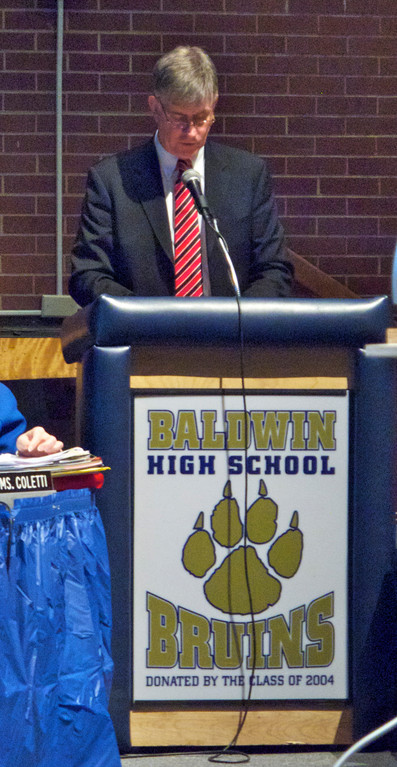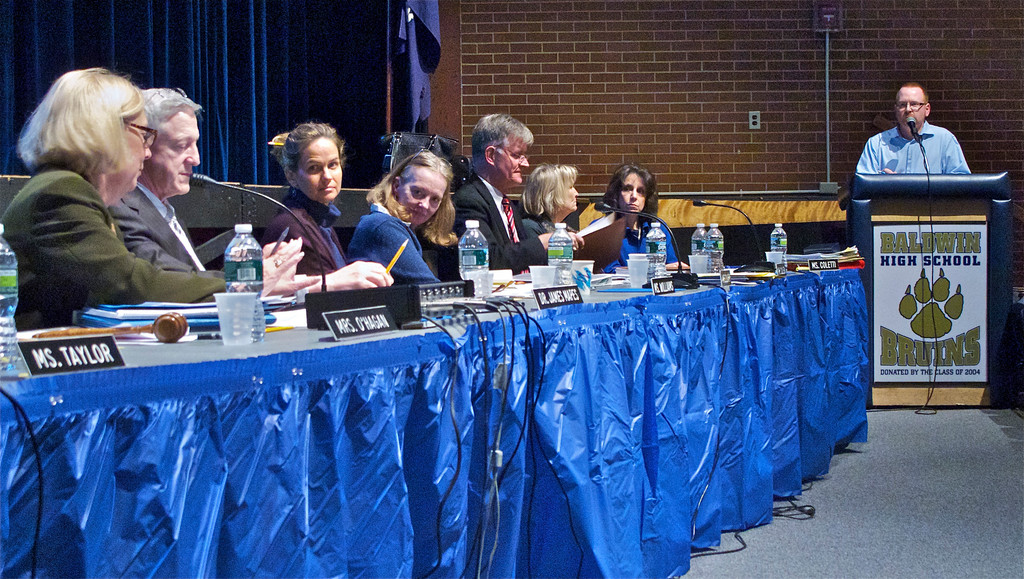Superintendent backs closures, suggests cuts
One week after the Baldwin Board of Education’s Facilities Review Task Force recommended the closure of two of the district’s elementary schools, Superintendent Dr. James Mapes weighed in with his recommendations to the board. They included closing the Shubert and Milburn schools and halving Baldwin’s kindergarten program, among other belt-tightening measures.
In his presentation to some 70 people in the auditorium at Baldwin High School on Feb. 1, Mapes made the following points:
n Shubert is the most underutilized school.
n It is nearly equidistant from the Brookside and Lenox schools.
n Brookside can accommodate Shubert students without additional transportation expense.
n Brookside has greater accessibility for disabled students.
n Current projections indicate that Milburn students can be accommodated at Steele.
n Growth at Milburn is limited.
n Steele has more total square footage than Milburn.
Forging on while protestations echoed through the auditorium, Mapes explained other measures he urged the Board of Education to include in the budget it will compile in the next two weeks. Stressing that no one wants to cut anything from the schools, he recommended that the board cut full-day
kindergarten to a half-day, reduce elementary school positions, increase class sizes, cut secondary teaching and administrative positions, restructure department supervision, reduce elementary art, music and phys. ed., eliminate some use of BOCES programs and make other reductions.
Mapes estimated that the gap between what the district needed to preserve its current operations and what it expected to get from the state and other financial sources is just under $4.7 million. His proposed cuts, he said, would exceed that total by approximately $50,000 — a sum he called “wiggle room” to accommodate a larger or smaller contribution from the state.
Mapes’s presentation was met by grim nods from the board and vocal complaints from some members of the Facilities Review Task Force. “You lied to us,” charged Tracy Mahler, a member of the facilities review group, adding that the district provided misleading information intended to nudge the task force toward the conclusion that schools needed to be closed. Mahler said that the board was ignoring measures — most prominently a reorganization of busing — that would create savings the board could use to keep at least one school open.
The budget work session format did not allow Mapes, or the members of the school board, to take questions from members of the public, but Mapes did address queries from board trustees. “Why these two schools?” asked Trustee Mark Clark.
“We were looking to minimize disruptions,” Mapes answered. “What we did was look for blocks of students we could shift together to maintain friendships — to keep groups of students together.”
“If we condense these schools,” Clark asked, “will the buildings be able to accommodate that in terms of picking up and dropping off kids?”
“There will be more traffic, obviously,” Mapes said. “It will be busier. But we looked into it, and it can be accomplished.”
Mapes also said he was confident that even schools projected to house a larger
number of students would be able to take in newcomers in the event of a population rise. He also intimated that the district has no plans to sell school buildings it may close. “The market is not right at the moment to sell those properties,” he said. “The district would maintain control of the buildings, but mothball them, so to speak.” He later
estimated that the cost of maintaining a decommissioned school building would be about $25,000 per year.
Following Mapes’s presentation, the board held a budget work session, during which the district’s assistant superintendent for business, Edward Cullen, broke down two segments of the budget process: capital and administrative costs. The third and largest portion of the budget — programs — was scheduled to be discussed on Feb. 8.
In a work session on Feb. 15, at 8 p.m. in the BHS auditorium, the board will vote to finalize the budget that is due to the state on March 1. The public is scheduled to vote on the budget on May 15. A comprehensive menu of budgetary information, including Mapes’s recommendations and Cullen’s presentations, is available on the district website, http://www3.baldwinschools.org/business. The district has also offered to provide the line-by-line budget to residents who request it.

 55.0°,
A Few Clouds
55.0°,
A Few Clouds 









